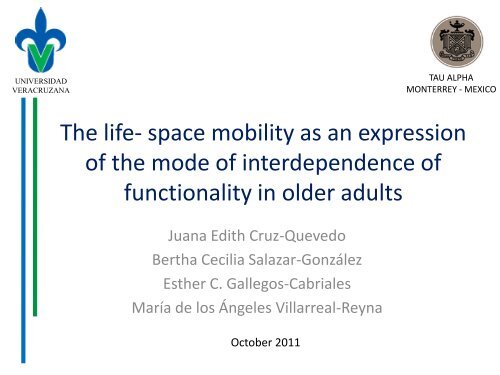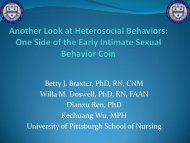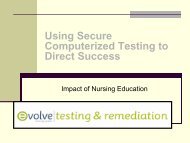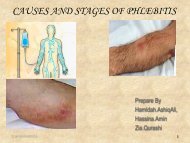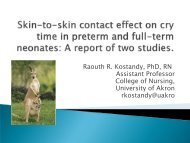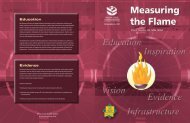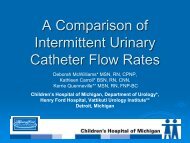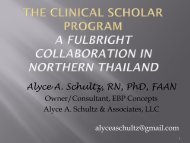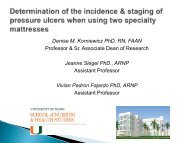Juana Edith Cruz-Quevedo
Juana Edith Cruz-Quevedo
Juana Edith Cruz-Quevedo
Create successful ePaper yourself
Turn your PDF publications into a flip-book with our unique Google optimized e-Paper software.
UNIVERSIDAD<br />
VERACRUZANA<br />
TAU ALPHA<br />
MONTERREY - MEXICO<br />
The life- space mobility as an expression<br />
of the mode of interdependence of<br />
functionality in older adults<br />
<strong>Juana</strong> <strong>Edith</strong> <strong>Cruz</strong>-<strong>Quevedo</strong><br />
Bertha Cecilia Salazar-González<br />
Esther C. Gallegos-Cabriales<br />
María de los Ángeles Villarreal-Reyna<br />
October 2011
Introduction<br />
UNIVERSIDAD<br />
VERACRUZANA<br />
Mobility is a complex function that reflects several<br />
areas of activity.<br />
• the most important skill needed to maintain an<br />
independent life, personal autonomy and low use of<br />
care services<br />
(Owsley, et al., 2006; Parker, Baker & Allman, 2007)<br />
• Limitations in mobility precede dependence<br />
(Baker, Bodner & Allman, 2006).<br />
“life- space mobility” concept<br />
• Extent of mobility of individuals from inside their home<br />
to locations beyond their community or geographical<br />
area of residence (Parker et al., 2002).
Introduction<br />
UNIVERSIDAD<br />
VERACRUZANA<br />
Reasoning:<br />
• A behavior of the physiological mode can have an effect or<br />
act as a stimulus for one or all the other modes (Roy &<br />
Andrews, 1999; p.114).<br />
• The interdependence needs are satisfied through social<br />
interaction at an individual level and with the support<br />
systems.<br />
When functionality is considered as the behavior of<br />
older adults:<br />
• Social relations that older adults engage in are determined<br />
by the structure or spaces in which they live and move.<br />
• It is in these spaces that individuals have the opportunity<br />
to interact with others and with their social environment.
Functionality as behavior<br />
UNIVERSIDAD<br />
VERACRUZANA<br />
Stimuli<br />
Physiological<br />
mode<br />
• Muscular<br />
strength<br />
Self concept<br />
mode<br />
• Perceived<br />
muscle<br />
strength<br />
Interdependence<br />
mode<br />
• Life-space<br />
mobility
Proposed mediation model<br />
UNIVERSIDAD<br />
VERACRUZANA<br />
Improvement<br />
in perceived<br />
muscular<br />
strength<br />
Improvement<br />
in muscular<br />
strength<br />
Improvement in<br />
life-space mobility
Methods<br />
UNIVERSIDAD<br />
VERACRUZANA<br />
Participants<br />
<br />
41 older adults who live in the Monterrey,<br />
NL, Mexico, metropolitan area and were<br />
recruited at gerontological clubs.<br />
• The average age was 71.8 years (SD =<br />
8.1);<br />
• 90.95 Women<br />
• Physically inactive (less than 9.4<br />
points in the physical activity<br />
questionnaire for older adults), with<br />
no cardiovascular, orthopedic or<br />
neuromuscular diseases and were<br />
not taking medications that could<br />
interfere with their safety. T<br />
• Those with medical contraindications<br />
to engage in exercise were excluded.<br />
<br />
<br />
<br />
<br />
Intervention<br />
12-week exercise program to increase<br />
muscular strength using Thera-band ®<br />
elastic bands.<br />
• focused primarily on the lower extremities; it had<br />
three 1-hour sessions per week at a moderate<br />
intensity.<br />
A session consisted of four series of six<br />
isotonic strength exercises with 10 to 15<br />
repetitions at 40% to 60% 1RM (weeks 3<br />
to 12).<br />
There was one week of practice prior to<br />
the program<br />
Following the guidelines from the<br />
American College of Sports Medicine<br />
(Fletcher et al., 2001; Kraemer et al., 2002; Mazzeo et<br />
al., 1998; Pollock et al., 2000).
Measurements and instruments<br />
UNIVERSIDAD<br />
VERACRUZANA<br />
Four different moments<br />
• Muscular strength : 1RM= F X Xrm<br />
• The Muscular Strength Scale from the physical<br />
self-description questionnaire (Marsh et al., 1994).<br />
• The alpha achieved in this study was .80.<br />
• The Life- Space Mobility questionnaire, the Life<br />
– Space Questionnaire: A measure of the Extent<br />
of Mobility in Older Adults (Stalvey, Owsley, Sloane & Ball, 1999).<br />
• The instrument authors report .80 of reliability in<br />
the test-retest tests (Parker et al., 2002).
UNIVERSIDAD<br />
VERACRUZANA<br />
Results<br />
Initial comparison of the groups<br />
Muscular Strength<br />
Intervention Group<br />
Squatting<br />
LL Bending<br />
RL Bending<br />
LL Pressure<br />
RL Pressure<br />
LL Extension<br />
RL Extension<br />
Control Group (n=19)<br />
Squatting<br />
LL Bending<br />
RL Bending<br />
LL Pressure<br />
RL Pressure<br />
LL Extension<br />
RL Extension<br />
Perceived Muscular Strength<br />
Variable Mean S.D.<br />
43.1<br />
19.0<br />
19.0<br />
27.2<br />
23.6<br />
34.2<br />
33.9<br />
20.6<br />
17.07<br />
16.2<br />
17.8<br />
15.7<br />
20.0<br />
22.2<br />
37.5<br />
9.3<br />
9.7<br />
27.4<br />
23.4<br />
46.3<br />
45.8<br />
25.2<br />
8.1<br />
6.1<br />
18.4<br />
14.5<br />
39.5<br />
44.1<br />
Minimum<br />
Value<br />
0.0<br />
6.8<br />
5.4<br />
3.15<br />
2.8<br />
4.5<br />
2.0<br />
0.5<br />
6.8<br />
8.0<br />
3.1<br />
2.8<br />
2.4<br />
1.2<br />
Maximum<br />
Value<br />
135.0<br />
46.4<br />
45.2<br />
103.2<br />
103.2<br />
173.7<br />
172.5<br />
85.8<br />
40.2<br />
27.1<br />
87.4<br />
69.3<br />
173.7<br />
172.5<br />
Intervention Group 72.5 15.6 31.2 96.8<br />
Control Group 75.3 10.8 46.8 87.5<br />
Life-Space Mobility<br />
Intervention Group (n=22) 58.5 16.1 11.1 77.7<br />
Control Group (n=19) 64.9 16.2 11.1 77.7<br />
*Without significant differences between the groups
UNIVERSIDAD<br />
VERACRUZANA<br />
Effect of the muscular strength on perceived muscular<br />
strength and life- space mobility; mediating effect of the<br />
perceived muscular strength<br />
Effect of the Change in Muscular Strength on the Change of Perceived<br />
Muscular Strength<br />
Coefficients B EE β t<br />
Constant<br />
Muscular Strength<br />
-3.40<br />
.191<br />
3.43<br />
.052 .508<br />
-.099<br />
3.68<br />
p<br />
Value<br />
.921<br />
.001<br />
F (1,20) = 13.58; p < .001; R 2 = .239
UNIVERSIDAD<br />
VERACRUZANA<br />
Effect of the muscular strength on perceived muscular<br />
strength and life- space mobility; mediating effect of the<br />
perceived muscular strength<br />
Effect of the Change in Muscular Strength on the Change in Life- Space Mobility<br />
Coefficients B EE β t<br />
Constant<br />
Muscular Strength<br />
1.91<br />
.13<br />
3.06<br />
.046 .411<br />
.624<br />
2.81<br />
P<br />
Value<br />
.536<br />
.008<br />
F (1,20)<br />
= 7.94; p < .001; R 2 = .148
Effect of the muscular strength on perceived muscular strength and lifespace<br />
mobility; mediating effect of the perceived muscular strength<br />
UNIVERSIDAD<br />
VERACRUZANA<br />
Paso 1<br />
Improvement<br />
in the muscle<br />
strength<br />
β= .130; p = .008; R 2 = 14.8<br />
Improvement in<br />
the life-space<br />
mobility<br />
Improvement in<br />
the perceived<br />
muscle strength<br />
Paso 2<br />
Improvement<br />
in the muscle<br />
strength<br />
β= .046; ns<br />
Improvement in<br />
the life-space<br />
mobility<br />
F (2,19) = 11.33; p < .001; R 2 = .341
Discussion<br />
UNIVERSIDAD<br />
VERACRUZANA<br />
The intervention had an effect on the physical mode represented<br />
by the muscular strength of older adults.<br />
• The magnitude of the effect achieved in each one of the exercised<br />
areas was large although different for each one of them.<br />
Variations may be explained by the intensity reached in carrying<br />
out the routine.<br />
• Previous studies report a maximum allowed intensity of 80% of the 1RM, while<br />
in this study the maximum reached was 60% of the 1RM.<br />
Physiological integrity (Roy & Andrews, 1999; p. 102).<br />
• One limitation of this study was that we did not take into account<br />
aspects that could affect the necessary physiological integrity in older<br />
adults in order to boost the effects of exercise
Discussion<br />
UNIVERSIDAD<br />
VERACRUZANA<br />
It was proven that by strengthening the physiological mode, the<br />
self-concept mode and interdependence mode were also<br />
stimulated.<br />
The mediating role of the perceived muscular strength between<br />
the muscular strength and the life- space mobility shows the<br />
regulating and innovating activity of the systems that show the<br />
holistic nature of human adaptative systems (Roy, 1999).<br />
The concept of life- space mobility proved that it can be considered<br />
as a manifestation of the interdependence mode in the<br />
functionality of older adults.
Conclusions<br />
UNIVERSIDAD<br />
VERACRUZANA<br />
The life- space mobility is considered as a manifestation of the<br />
interdependence role.<br />
• In turn, it is interrelated with other modes, such as the physiological mode and<br />
the self-concept mode.<br />
• The self-concept mode acts as mediator between the physiological mode and<br />
the interdependence mode.<br />
Considering these three manifestations in the functionality of older<br />
adults and the way in which they operate, will enable us to<br />
advance in understanding this group’s functionality and use them<br />
to promote methods of intervention that, based on the theory, will<br />
aim to preserve it.


